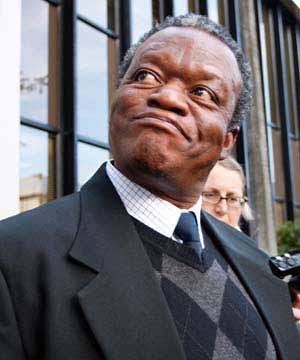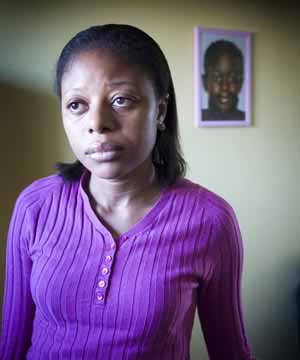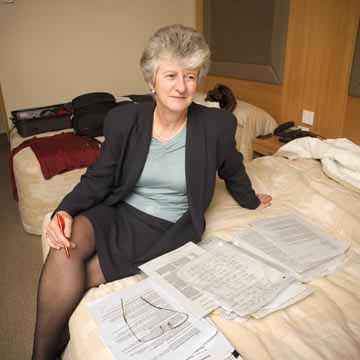What the public didn't hear about
the death of Charlene Makaza Sunday Star Times | Sunday, 25 May 2008 CHARLENE MAKAZA went into hospital as a victim of HIV. By the time she died 18 hours later, doctors had decided she was a victim of murder. 
George Gwaze gets a hug from his daughter Maggie as he leaves the
Christchurch District Court after being found not guilty on charges
of murder and sexual violation on May 21, 2008 in Christchurch.
�?MARTIN HUNTER |
Their testimony in the High Court at Christchurch over the past month that the 10-year-old Zimbabwean girl had suffered atrocious genital injuries and been suffocated in a sexual assault could have seen an innocent man jailed for life. Wednesday's acquittal of Charlene's uncle, vet George Gwaze, 56, on murder and sex charges would have surprised many. But that is because the public has been misinformed about Charlene's case since she died on January 7 last year. This is what police told the media in the days following the death: - Charlene did not die by accident or natural causes.
- There was no evidence she was sick or ill.
- Charlene had been suffocated.
- Charlene was found in her bed having difficulty breathing.
- Her family washed her bedding and clothing after she was the victim of a "horrific" sexual assault.
- Police had been briefed on African beliefs about sex, including the myth that sex with a virgin could cure Aids.
By the time the Crown revealed at a depositions hearing in July that George Gwaze's semen had been found on Charlene's underwear, the court of public opinion had found a new hate figure.  
George Gwaze leaves Christchurch District Court after being found not guilty on charges of murder
and sexual violation on May 21, 2008 in Christchurch, New Zealand. Gwaze was charged with
the rape and murder of his 10 year old niece Charlene Makaza on January 07, 2008 (left).
George Gwaze's daughter Maggie with a portrait of Charlene Makaza, who died last year (right).
�?MARTIN HUNTER. |
But this is what really happened and this, in the first days after her death, is what we were NOT told. Charlene was indeed found in her bed at 6am having difficulty breathing. But she was deeply unconscious and awash in her own diarrhoea. It was like porridge, chalky, white and watery. There was so much of it that it had plastered to her legs, the white skirt and pink undies she had worn to bed and drenched her bedding. When her aunt, Gwaze's wife Sifiso, changed her into new clothes before rushing her to an emergency GP clinic, the faeces continued to pour out and soaked those clothes as well. In the end Sifiso wrapped her in a towel. By the time Charlene got to a 24-hour accident and medical clinic, she had a temperature topping 40°C, a racing pulse over 180, and no recordable blood pressure. She had lost so much fluid from her blood because of the diarrhoea that she was in what was known as hypovolemic shock. There wasn't enough blood to pump to her brain, causing the oxygen deprivation that was later attributed to suffocation. Charlene was regularly unwell. She had 20 days off school the year before. 
Charlene Makaza, 10, was a student at Wairakei School. | 
Expert sex abuse witness Dr Felicity Goodyear-Smith.
�?MARTIN HUNTER | The evening before her collapse an elder at her church noticed she was hot to the touch and was having difficulty with her breathing. Charlene had contracted HIV at birth from her mother Senzeni who died of HIV-related tuberculosis when Charlene was nearly two. Senzeni's husband Edgar also died of Aids in 2000. Charlene's "horrific" anal injuries amounted to a series of tiny lateral tears and such fissures have been reported in HIV-Aids patients. Charlene's older sister Charmaine, 12, had chicken pox a virus that could prove devastating to a child whose immunity was as compromised as Charlene's. The semen on Charlene's underwear always looked bad for George Gwaze. When the defence raised the suggestion of innocent transfer through the wash, it was easy to see how the first reaction could have been "Yeah, right". But defence counsel Jonathan Eaton's DNA adviser, Arie Geursen the scientist whose work helped to free wrongly convicted David Dougherty in 1996 was in no doubt, given the other facts of the case, that innocent transfer was the most likely explanation. The morning Charlene was found near death in her bed, Sifiso had returned home from hospital after being told Charlene was likely to be transferred to Auckland's Starship Children's Hospital. Sifiso rinsed all Charlene's soiled sheets and clothes and threw them in the washing machine. It was from here that police recovered the underwear on which Gwaze's semen was found. But that morning there was none of George or Sifiso's underwear, which could have been the source of such contamination, in the same wash. So how could semen be transferred? Sifiso's habit was to wash underwear her own and Charlene's, in a hand basin together, or throw them in the machine if there was a full wash. For Geursen, the contamination theory came down to scientific facts, and the lack of any other evidence of a sexual assault. Gwaze's DNA was not found anywhere else on Charlene, nor Charlene's on him. The average male produces around 130,000,000 sperm heads in each ejaculation. A peer-reviewed international study has found that cotton underwear retains 43% of the DNA after it's been through each wash. "So you have to do quite a few washes to reduce DNA below the detectability of the tests," he says. That means the contamination could well have occurred in an earlier handwash. The total DNA sample from Charlene's underpants was the size of about one hundred thousandths of a single grain of sugar. Had Gwaze been convicted, says Geursen, it would have been "a terrible travesty of justice. It would have been science and medicine gone astray". So how did things go so badly wrong for George Gwaze? GP and forensic physician Felicity Goodyear-Smith, the medical adviser for the defence, believes that once sexual abuse had been raised, other possible explanations were never considered. And because Charlene's care was handed over between shifts, those on duty later lost sight of her first symptoms. "They were well-intentioned but totally wrong. The fact that she was admitted with sepsis and hypovolemic shock was lost in the retelling. "Once you get a particular line of thought, like this is sexual abuse, it colours thinking," she said. "And these were very senior people saying it was abuse. If it IS sexual abuse that doesn't matter, but suddenly the possibility that it might not be isn't on the table any more so everything is focused on looking for evidence of it and this is really what this case typifies." Goodyear-Smith says at first, she too thought the odds were stacked against Gwaze. "It looked very damning, and very difficult. But when I went through it bit by bit and produced a timeline it all fell into place and then it became incredibly compelling that there was actually no crime. Even though there may be strange coincidences, there are explanations for all of it." On her timeline, the turning point in medical opinion as to the cause of Charlene's death came at around 1pm when a rectal probe was inserted to take a more accurate temperature. Nurses alerted consultants to what they thought was a "meaty open wound" in her anus, or a rectal tear. A paediatric consultant put the size of the wound at around 7cm while a nurse described it as "a wound you would never forget". Quickly, attention switched to a possible sexual assault and the infection being caused by the anal injury. By the time Charlene took her last breath 12 hours later, with Sifiso holding her hand and the rest of her family looking on, police were stationed outside. And when pathologist Martin Sage reported the results of his autopsy the following day that Charlene had likely been suffocated and her genital injuries were consistent with forcible penetration the prosecution had its murder victim. But when the jury delivered its not guilty verdicts on Wednesday afternoon, the Gwaze case became a judicial rarity a murder trial without a murder. There was a victim, but no crime. There were no gaping genital wounds, either, says Goodyear-Smith. She believes what the doctors and nurses were actually seeing was a swollen and distended anal canal caused probably by a combination of the severe diarrhoea, Charlene's HIV-Aids status, and the fact she was being pumped with litres of fluids to increase her blood pressure. "There was no 7cm laceration. There were lots of tiny fissures but there wasn't a big tear. But that's what they thought they saw and they went ‘gasp�?" Sage's autopsy report made no mention of a 7cm tear, referring only to cracks in the anal tissue, the largest of which was 5mm. But he thought these could not be explained by natural causes. What the doctors were in fact looking at was a very rare HIV-related death in an untreated child. Charlene, who arrived in Christchurch with Sifiso and Charmaine in October 2005, had never had an HIV test. Though tests in Zimbabwe showed her immunity was lowered and HIV was suspected, she didn't have an Aids-defining condition that would have triggered treatment. And because she came here on a student visa, she didn't have an HIV test. The family probably knew Charlene was infected, but chose to treat problems as they occurred, pointing to Zimbabwean children dying with Aids despite aggressive treatment. Goodyear-Smith says she approached HIV experts and pathologists to help but found it difficult to get experts willing to testify. "It is very difficult because if you do come out for the defence against your colleagues you may end up as a pariah." Goodyear-Smith has tracked Charlene's 18 hours in hospital, almost by the minute. Every test, every scan, every examination. "Their attempts to save Charlene's life were heroic," she says. "They did everything right. The only thing wrong was the diagnosis."
MEDICAL TIMELINE JANUARY 06, 2007: 6am: Charlene found in bed, covered with diarrhoea, unconscious, no recordable blood pressure. 6.45am: Arrives at GP clinic. Meningitis or encephalitis suspected. IV drip. Immediate transfer to Christchurch Hospital. 7.15-10am: Airway tubes and catheter inserted, antibiotics started, IV lines introduce saline. Blood tests taken. Blood pressure rises to 130/60. X-rays and vaginal swab taken, nasogastric tube inserted. Charlene has seizure; blood pressure drops to 65/20. Registrar records diarrhoea. Meningococcal septicaemia or brain abscess suspected. Charlene in deep coma, peripherally shut down. Starship hospital consulted. X-rays show fluid on lungs. Vaginal discharge and redness. 10.30am: Transfer to ICU. Results of first CT scan show encephalitis or oxygen deprivation. Preliminary diagnosis viral or bacterial infection. 12.30pm: George and Sifiso go home to pack bag and clean up. Do washing. 1pm: Nurses trying to insert rectal thermometer find what they believe is large, open anal wound. Consultants called, digital photos taken. Consultant surgeon called in. Doctor calls Sifiso at home, asked about past medical history and what she found on bed and clothing. 2pm: Rectal exam with proctoscope shows no evidence of rectal penetration. Doctors discuss whether Charlene was suffocated during sexual assault. Starship team arrives but decision taken that Charlene is dying and will not be transferred. 2.45pm: Tests taken in morning find HIV-positive. Social worker told to notify CYF and police. 3-4.15pm: Sex abuse doctor called in. Hospital staff advise Gwazes of anal injury. 6-8pm: Gwazes told Charlene is brain dead. Sex-abuse doctor calls pathologist. Police liaise with pathologist. 8-9pm: Another rectal exam with proctoscope reveals anal canal bruising, no evidence of perforation but pinprick haemorrhaging. Haemorrhage on hymen. 10-11pm: Third proctoscopy; swabs taken. Two police officers in ICU. Doctors show Sifiso injury to rectum. Family told Charlene is dying. JANUARY 07: 1.05am: Charlene certified dead. 10am-3.30pm: Autopsy carried out. JANUARY 08: 6-7pm: News and radio reports quote police saying pathologist has reported Charlene was suffocated.
http://www.stuff.co.nz/sundaystartimes/4558377a6619.html |  Free Forum Hosting
Free Forum Hosting